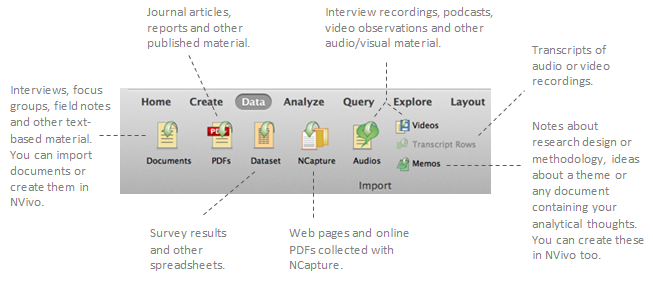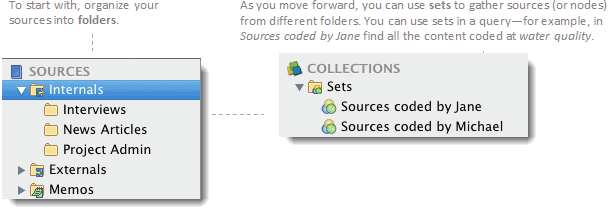Bring in your sources and get organized
The type of source material you include in your project depends on your research question and methodology—and NVivo lets you import a wide range of materials from interview transcripts and journal articles to audio or video recordings.
Refer to About Sources for detailed information about the types of data you can import. This topic provides some ideas for collecting your data and organizing it once you have brought it in.
In this topic
- Bring your sources into NVivo
- Collecting your data
- Working with transcripts
- When do I import my data and how much is enough?
- Ways to organize your sources
Bring your sources into NVivo
Use the options on the Data tab to import your source materials:

Collecting your data
Some ideas to consider during data collection:
-
Even if you cannot import a file directly into NVivo any digital content that you can save, print or export in PDF format (web pages, PowerPoint presentations, spreadsheets) can be imported into NVivo for analysis.
-
Capture information about the setting, social context, body language or tone. It also helps to record your first impressions and interpretations—these can be hard to remember later on. You can create or import this information as a memo in NVivo.
-
Record the demographic details of your participants—you could do this in a text file and then import it (or add it directly in NVivo).
- Recording equipment can be distracting— take note of how the presence of the camera or recorder affects participants (create or import this information as a memo).
-
Keep a log of what you are doing—date and time, location, the events that took place, the surrounding conditions and your personal feelings about the events.
-
Do you require consent from all participants? To keep everything in one place, consider importing consent forms as sources in your project.
-
If you want to edit audio or video recordings—for example, cut out irrelevant video footage— you will need to do this before importing the material into NVivo.
-
Many ethnographic and social research projects ask participants to record their own experiences. If you are gathering this type of data, be aware that people have different levels of expertise in using video/audio equipment and you may end up with large amounts of unusable material. Ask participants to keep a log of what they are doing and why they chose to record particular events.
Working with transcripts
If you have interview or focus group transcripts saved as Word documents (or text files), you can import them as document sources in NVivo. You may also want to use annotations to capture the tone of the conversation, including body language and displays of emotion.
If you have audio or video recordings of interviews or focus groups, you can import the media as audio or video and include a synchronized transcript.
There are a number of ways to approach transcription—for example, you can:
-
Transcribe the media in NVivo —you can play and pause the media, transcribing as you go. To support this process, you can use options on the ribbon or shortcut keys.
-
Import a transcript as long as it is in the correct format.
-
Work without a transcript—you can code directly on the media timeline.
When working with synchronized transcripts, you may want to consider the following:
-
You can experiment with the dictation feature (Edit > Start Dictation) provided with OS X 10.8 Mountain Lion or later.
-
There are benefits to transcribing your own material—the transcription process brings you closer to your data (helping you to form early impressions) and you have control over the accuracy and completeness. Of course, this may not be practical on large scale projects and you may prefer to get your materials transcribed. The integrated transcription service (provided by TranscribeMe) is not available in this release.
-
If you decide to work with audio or video directly (without a transcript), you will not be able to use Word Frequency or Text Search queries to explore the content.
When do I import my data and how much is enough?
You can import source material at any stage of your project.
Depending on your research design and methodology, you might import all your source material and then begin analysis—or, you may continue to collect and analyze data until you reach a point of saturation (when you are no longer hearing or seeing new information).
The other question to consider is whether you have gathered a variety of data to support your research question—this concept is commonly referred to as triangulation. Looking at a topic from more than one standpoint can increase the validity and credibility of your findings. For example, you might use more than one method to gather data—combining interviews with observations, surveys and social media content. In NVivo, you can check whether an emerging theme is valid by running a matrix coding to see it if appears in different types of sources.

Ways to organize your sources
NVivo provides flexible ways to organize your data using folders and sets—you can experiment to see what suits you best.

You can also use source classifications as a way to organize or compare sources based on their attributes—for example, find all the articles by a particular author or all the interviews that were conducted by Mary.


 Top of Page
Top of Page